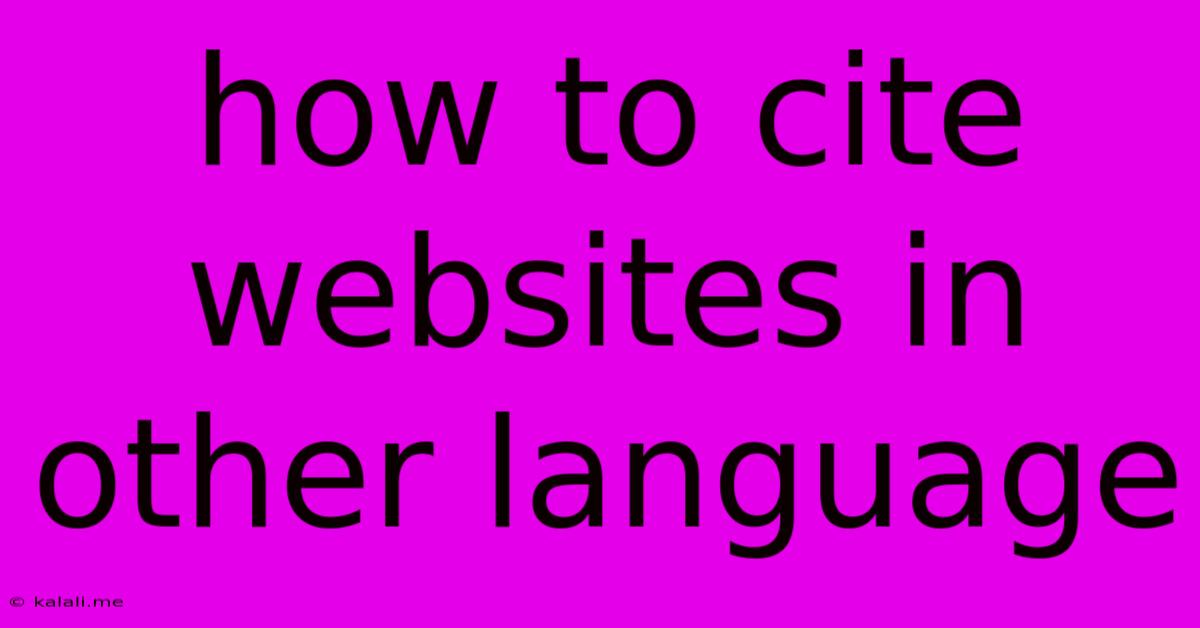How To Cite Websites In Other Language
Kalali
Jun 11, 2025 · 3 min read

Table of Contents
How to Cite Websites in Other Languages: A Comprehensive Guide
Meta Description: Learn how to properly cite websites in other languages using common citation styles like MLA, APA, and Chicago. This guide covers everything from translating titles to handling special characters, ensuring accuracy and consistency in your academic work.
Citing websites, even those in other languages, is crucial for academic integrity. Whether you're referencing a Spanish news article, a French academic journal, or a German blog post, the underlying principles remain the same: accuracy, consistency, and adherence to a specific citation style. This guide will walk you through the process, addressing the unique challenges posed by non-English sources.
Understanding the Basics of Website Citations
Before diving into language-specific considerations, let's review the fundamental elements of a website citation. Regardless of the language, you'll generally need the following information:
- Author: The name of the person or organization responsible for the content. If unavailable, use the website name.
- Title of the Website: This should be the full name of the website, not just a page title. Accurate translation is crucial.
- Title of the Specific Page/Article: The title of the specific page or article you're referencing. Translation is often necessary here as well.
- URL: The complete web address.
- Date Accessed: The date you accessed the website.
- Date of Publication (if available): The date the website or specific page was published.
Translating Titles and Maintaining Accuracy
Translating titles from other languages is often necessary for clarity and consistency within your bibliography. However, you should strive to maintain accuracy. Avoid overly informal or subjective translations. Consider using professional translation services or consulting reliable dictionaries if you're unsure about the best way to render a title in English.
When citing in your bibliography, you can include the original title in the language it was written, followed by a translated version in parentheses. For example:
Original Language Title [Translation in English]
This method allows for both accuracy and reader comprehension. Remember to be consistent in your approach throughout your bibliography.
Handling Special Characters and Accents
Many languages utilize special characters and accents that might not render correctly in your citation manager or word processor. To prevent errors, ensure you utilize the correct character encoding (typically UTF-8) in your document. This will allow for proper display of these characters. Avoid manually substituting characters, as this can lead to inaccuracies.
Citation Styles and Language Considerations
Different citation styles (MLA, APA, Chicago, etc.) have specific guidelines for formatting website citations. While the fundamental information remains consistent, the order and punctuation may vary. Here's a brief overview:
- MLA: Generally prioritizes author and date information. The URL is placed at the end. Ensure accurate title translation.
- APA: Focuses on author, date, and title, with specific formatting requirements for the URL. Proper translation of titles is paramount.
- Chicago: Offers both author-date and notes-bibliography styles. Accurate translations and consistent formatting are key, regardless of the style used.
Examples of Citations in Different Styles
While providing concrete examples is difficult without specific sources, here's a general structure demonstrating the principles:
(Note: Replace bracketed information with actual details.)
MLA:
[Author's Last Name], [Author's First Name]. "[Title of Page/Article]." [Website Name], [Date Accessed], [URL].
APA:
[Author's Last Name], [Author's First Name]. ([Year, if available]). [Title of Page/Article]. [Website Name]. [URL].
Chicago (Author-Date):
[Author's Last Name], [Author's First Name]. [Title of Page/Article]. [Website Name], [Date Accessed]; [URL].
Conclusion
Citing websites in other languages requires attention to detail and accuracy. By carefully translating titles, handling special characters appropriately, and adhering to a consistent citation style, you can ensure the integrity of your academic work. Remember to always double-check your citations against the specific style guide you're using. If you have any doubts, consult a professional or seek clarification from your instructor.
Latest Posts
Latest Posts
-
Which Of The Following Is System Software
Jun 12, 2025
-
Truth Table For 3 Input Nand Gate
Jun 12, 2025
-
What Are The Colours Of The Five Olympic Rings
Jun 12, 2025
-
Moment Of Inertia Of A Semicircle
Jun 12, 2025
-
What Is The Molar Mass Of Hno3
Jun 12, 2025
Related Post
Thank you for visiting our website which covers about How To Cite Websites In Other Language . We hope the information provided has been useful to you. Feel free to contact us if you have any questions or need further assistance. See you next time and don't miss to bookmark.